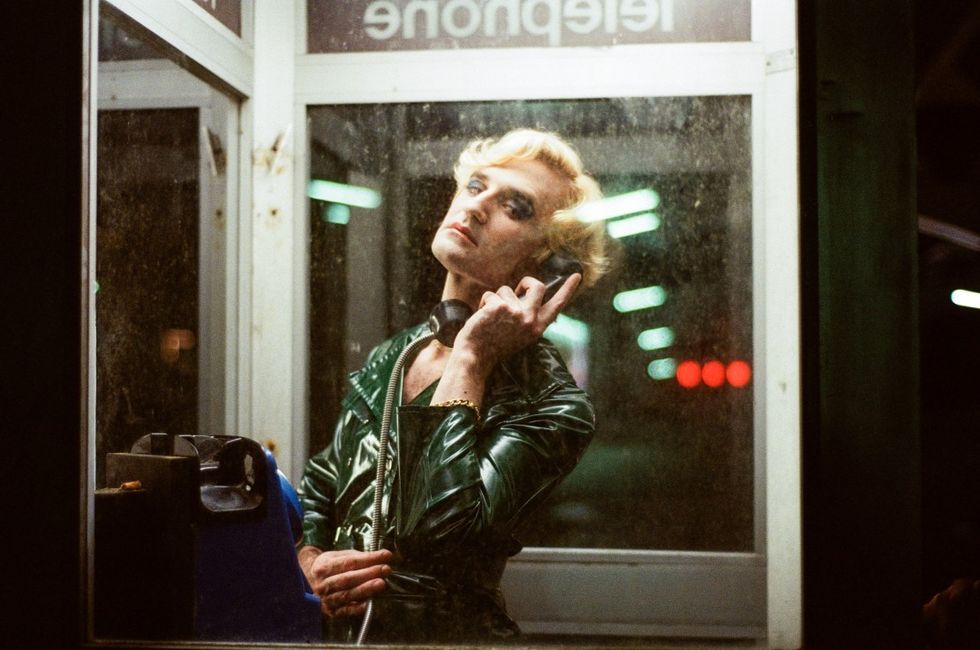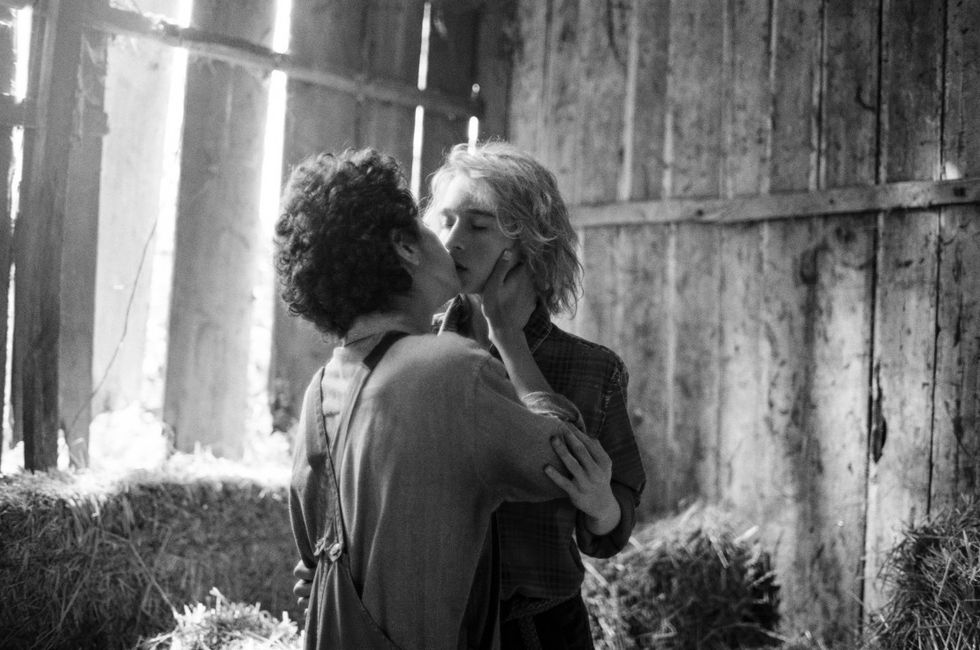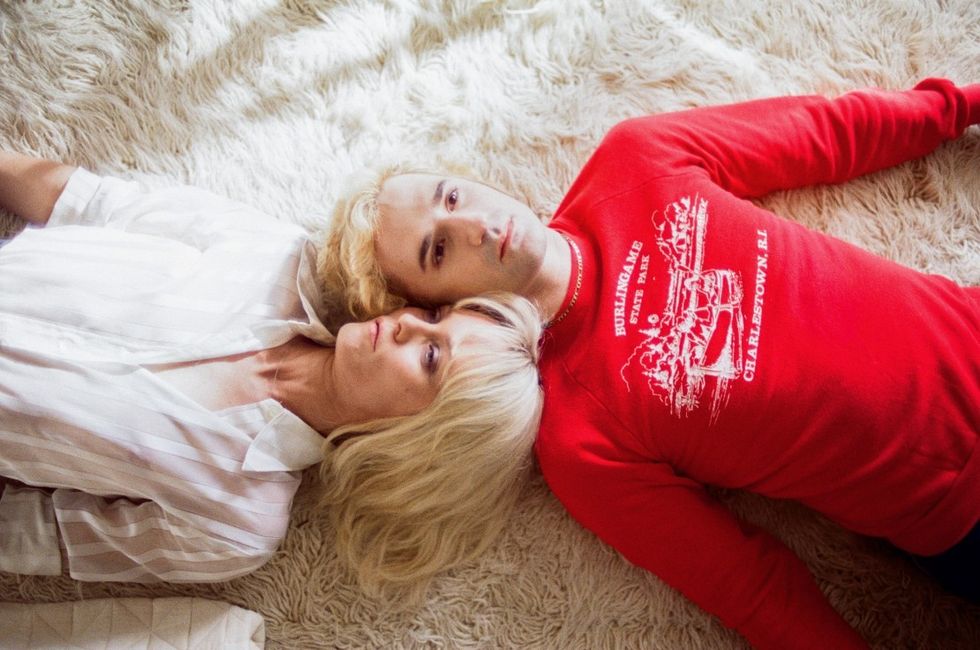Crossing a Vintage Porn Style with Giallo Aesthetics: Yann Gonzalez on 'Knife + Heart'
Fans of Brian De Palma and Dario Argento should take note.

While a handful of genre movies at this year’s Fantastic Fest featured queer characters, only Knife + Heart so openly directly dealt with different experiences in an LGBTQ community. The French film is a serial killer story that investigates the tragedy of internalized homophobia with a giallo twist and more than a nod to the movies of Brian De Palma and Dario Argento. Yann Gonzalez’s second film is delightfully campy and sensual yet heartbreaking and terrifying.
Anne (French pop star Vanessa Paradis) is a lesbian porn producer who specializes in making low budget gay porn in 1979. However, her life is far from the party atmosphere she likes to keep on set. Her romantic relationship with her film editor (Kate Moran) is deteriorating, and members of her cast are turning up brutally murdered. Without help from the Parisian police, Anne decides to track down the killer on her own.
Shot on 35mm and loaded with synth-heavy music from M83, “Knife + Heart” is a twisted period piece that mixes murder mystery, workplace drama, and romance. At Fantastic Fest, Gonzalez revealed some of the film’s deeper themes, how he recreated his vintage aesthetic, and why he chose to shoot his movie on different film stock.
No Film School: There are so many twists and turns in your story. How did you map out the plot?
Yann Gonzalez: I actually was inspired by a real porn producer from the 1970s. I think she died like 20 years ago or something like that, so I never met her, but I liked the idea of a woman surrounded by young guys, taking advantage of them. To me, she was kind of ahead of her time, because she was a businesswoman and working only with guys.
She was making gay porn films and she was a pioneer because she was the first woman to do this in France and maybe in the whole world. She had a relationship with her editor in the film. I really thought it was a very interesting way to show her feelings. To me, it's like love going through the images.
NFS: And aesthetically, you really channeled the spirit of 1979 in the film.
Gonzalez: It was really important to me to show this community of people being free and being sexually liberated before the horror of AIDS. Before this disaster.
"I love when love comes to an extreme and you can't even face it because it's like struggling with your inner monster."
NFS: Even the supporting cast seems fairly well-developed, with personalities shining through even in their brief scenes. How did you establish the different dynamics between characters?
Gonzalez: I'm really happy that you mention that, because to me it's equally important for secondary or first characters. You just have to bring some emotions to the screen. You're part of my image, so you have to be lively. I love my characters, I've been dealing with them for four years now (because I started to write the screenplay four years ago). To me, choosing the right actor to play the right character is a very serious game. You really need to find somebody, maybe somebody that you pick up along the streets because you think that his face is super interesting, even if he didn't make pictures before. It can be a professional actor or somebody that you find in the club, for instance. I found a lot of people in clubs.
NFS: Which is kind of what Anne does in the movie.
Gonzalez: Exactly. Maybe the producer is kind of a self-portrait. I really feel close to her. I hope I don't go that alcoholic, but I love the intensity of her emotions. I'm really playing with that in all my films, but I love when love comes to an extreme and you can't even face it because it's like struggling with your inner monster. I think she's really struggling with her inner monster, also an outside monster.

NFS: You also play with the audience’s suspicions as to whether or not she’s the killer or connected to the killer.
Gonzalez: Actually, I tried to build some echoes between the two characters. To me, they share the same violence, but one is a violence made of love. The other is violence made of anger and murder. I don't know if, visually, I tried to create something that could link them, but all-in-all it's the first thing we shot on film—on 35mm and 16mm for the porn films.
"Shooting on film is a statement today because you're creating something very colorful (and very soft) on the skin of the actors."
NFS: I was wondering about that, because you have this very nice faded or dark quality to your images.
Gonzalez: To me, everything had to be organic, had to be on film, like it was in the 1970s. We rescreened the 35mm prints in the cinema at the end of the movie. It's a real 35mm playing on screen. It was a mess because nobody does this anymore, but it was great.
Shooting on film is a statement today because you're creating something very colorful (and very soft) on the skin of the actors. I really wanted to work on this dream quality in the film, this dreamy atmosphere. At the same time, I wanted to be incorporeal and have it not belong to any era. I wanted the viewer, the audience, to forget, after maybe 10 or 15 minutes that the film was set in the seventies. Like somewhere you don't know, you just forget.
NFS: I was also intrigued by the love and collaboration between the producer and the editor, and how close we have to work together to make movies. How did you shape the dynamic between the two?
Gonzalez: We're coming in at the end of their relationship, so that's a very different part than when things are working well. To me, my main character has a naivety to believe that she can seduce the woman of her dreams again with images, and of this faith put into movies, put in cinema, that you can make somebody fall in love again with you because you're creating images. This is what I believe, like a teenager.
I have this belief that if love is consuming enough on film, it can touch the person. So, it's very naïve, but at the same time, it's what makes the character moving and emotional for me.

NFS: There's also a third visual style in the film, and that's the black-and-white negative for the memory sequences. Why did you decide to do those sequences in that way?
Gonzalez: It's like a film waiting to get revealed. That's why it's seen in negative. It's a story that's waiting to be revealed, as well. To me, it was logical in terms of visuals to have this kind of cold quality of the image, very grainy, very dark, like images taken from a coal mine. I watched a lot of films with those kinds of images, especially one film that I really like, a Spanish film from Carlos Saura called Peppermint Frappe. There are beautiful images on the reverse, in the negative, at the end of his film.
NFS: I was also struck by the lighting of the movie, like in the club and night scenes, where you have this really nice glowy quality to the shots.
Gonzalez: Yeah, it's a glowy quality really inspired by films from the seventies. You had this blueish streaks in the film, especially in the French films from that era. Most of the films from that era have these blue street lights. After the late eighties, they started to change because the street lights changed after the seventies. Now all the streets in France are orange, and to me, it's not a good color on film especially when you work on 35mm. It was important—we spent a lot of money on this—to find the old neons and put the old neons from the seventies in the streets again. We really worked on this to find the right colors of the era.
"When you see a location, it's like love at first sight. When you meet somebody and you know it's the right person, it's the same with the locations."
NFS: You obviously know a lot about what kind of color quality you're looking for in your movie. How long did that take to finally figure out “If I want my shot to look like this, I have to do that”?
Gonzalez: You know, it's conversations and dialogue with my DP and of course the set designer of the film. It's like a threesome. During some pre-production, we're just starting to dream about the film and how it's going to look like. At the same time, we have to deal with reality. When you start, you don't have the locations, you don't have anything. So you build out of nothing so you can dream. The dream then starts to fade a little bit away and you have to build it again out on the locations you find. Locations are really the main core of the film, of your image. When you find the right location, 50% of the work is done for me. I think it's 40% location, 40% the actors, and then 20% of something magical.
NFS: And when do you know a location is the right one?
Gonzalez: You just picture a scene or you don't. When you see a location, it's like love at first sight. When you meet somebody and you know it's the right person, it's the same with the locations. You have to feel it, to feel that you can dream of this location and you can build with this location in mind. It's mystery. This is what I love about cinema. You bump into something, you bump into someplace, and it's the right place. It's incredible. It's like there's a little angel somewhere guiding you to the right place every time.

NFS: How did you decide on the music for the movie?
Gonzalez: There was the original soundtrack made by my brother, and then we picked out seven or eight tracks from the seventies and maybe one track from today. This is the same thing. It's music that brings the atmosphere. It brings the dream and the emotions of the film. Music is really at the center of my work.
I work a lot with my husband, who is a music supervisor. We have really the same taste in music and he's super good at finding the obscure gems, especially this Spanish song in the film in the disco place. It's something that nobody knew before and everybody fell in love on the set with this music. When we were partying after a week of work, we were always putting this music on. Everybody, all the actors, the technicians, everybody was dancing to this music. It was incredible.
NFS: The killings are staged in very different ways, with some more outrageous than others. One character is killed by a knife hidden in a dildo and another is slowly stalked by the killer as the audience watches the approaching horror through a spinning camera. How did you come up with some of those ideas?
Gonzalez: It's different stories for different sequences. It could be ridiculous, it could be super grotesque. But at the same time, the more grotesque it is, the scarier it gets. In giallo movies, there are lots of very stupid ideas, but they are so in your face. You can feel the director is so much in love with those stupid ideas. That becomes super strong, super powerful. I think when you believe in something—even stupid— in a very strong way, it can be super scary, or it can be emotional. I like to play with the grotesque tools in the film, grotesque sequences in the visuals.
And about the 360 camera movement, I was actually smoking a joint! I was at my place, and it was during the weekend. I was shooting this sequence in maybe 10 days. I was just thinking of the way it could be shot. I smoked weed, and I thought about this crazy movement and I was super excited about it. Sometimes when you're stoned, you're excited about something, and the day after it's "Wow, how shitty it is.”
I started to talk about it with my DP. I think he was a bit scared about the idea, and he thought it was a bit stupid, too. But when we tried it on set, it worked super good. I was happy with it.
NFS: Now this is spoilery, but I wanted to ask about the ending of the movie. The killer is revealed in a porno theater and members of the audience beat up this person who was murdering gay men. Was that in your mind when you wrote that?
Gonzalez: Of course. It's like stabbing society. Originally, the ending of the film was different, but when I heard of the Orlando killings, I was so struck. It was something super intense, and it made me really super sad. The fact that the killer was a closeted gay guy, it was horrible.
For me, it was a cathartic way to portray this Orlando feeling in myself and to think that the victims could turn against the monster. At the same time, I think of a monster because it's a gay guy becoming psycho, but he really lived tragically. It's different of course, but it was like trying to reverse this horrible feeling you have when you research tragedies, like this one in Orlando. Ruder, I think, and darker, but at the same time kind of cathartic.
For more information on the film, please click here.











